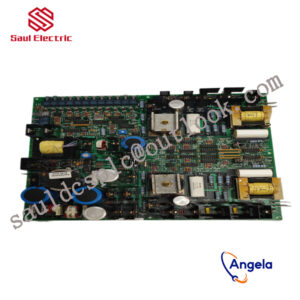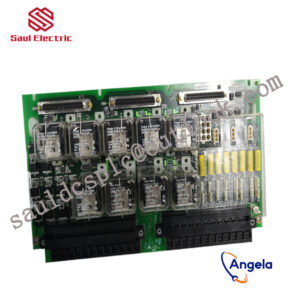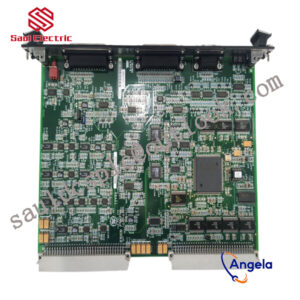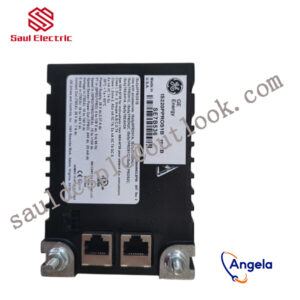Description
IS410STCIS2A Product Introduction
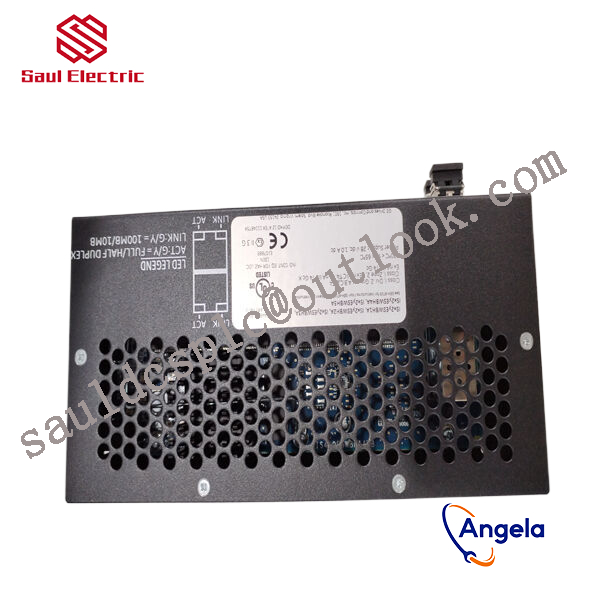
The specific application scope of the product
will depend on the needs of system integration and industrial application, but generally speaking, this type of embedded controller module can be applied to the following categories:
manufacturing processes, etc.
monitoring and control system.
of the controller module, as well as the specific needs of the customer.
designed to manage gas or steam turbines.
It has a CIMPLICITY graphical interface and an HMI with software suitable for running heavy-duty turbines.
be installed at the bottom of the cabinet. For a small setup that is easy to serve a triple redundant system, up to three components can be installed side by side.
he board can operate within a temperature range of 0 to 65 degrees Celsius without the need for a fan for cooling. NFPA Class 1. This board can be used for two applications.
Design of ABB industrial robot deburring and grinding workstation based on RobotStudio simulation softwareintroductionAs an official offline programming software for ABB robots, Robotstudio not only has powerful simulation and offline programming functions, but also has automatic path generation function and simulation monitoring collision function. It can realize the simulation of robots in real scenes, so as to timely update existing robot programs. optimize. On-site teaching programming will affect normal production activities on site.The application of Robotstudio software offline programming can reduce on-site teaching and programming time.As a traditional process of mechanical processing, deburring and grinding have a wide range of applications. However, for a long time, in the process of manual deburring and polishing, there have been differences in operations between workers. The manual operation is not repeatable and the deburring effect is unstable, which has seriously affected the surface quality and service life of the finished product; and the working environment There is a large amount of dust floating in the air and the conditions are harsh, seriously endangering the physical and mental health of workers. With the proposal of “Made in China 2025”, intelligent manufacturing production has become an important development direction for the transformation and upgrading of the future manufacturing industry. The use of industrial robot automated production lines for repetitive batch processing operations can not only greatly improve production efficiency, but also greatly improve product quality. Yield and production stability. Therefore, before designing the robot polishing program, if the shape, size and polishing amount of the workpiece to be polished are known, the robot offline program can be written on the Robotstudio software according to the existing conditions, thereby improving the efficiency of on-site programming.1Design task descriptionThis task is to create a new simulation workstation in ABB robot simulation software Robotstudio. The corresponding training equipment in reality is the Yalong YL-l360A industrial robot deburring and grinding system control and application equipment. The industrial robot selection and method of the simulation workstation are The grinding head installed on the blue plate refers to the Yalong YL-l360A industrial robot deburring and grinding system control and application equipment, and the workpiece is customized. The ABB industrial robot deburring and grinding workstation simulation training process includes: creating a workstation, setting up tools, creating smart components, creating tool coordinate systems, creating trajectories, programming, simulation design, and verification.2 Task implementation2.1 Create a workstationImport the robot: First, create a new simulation workstation in the Robotstudio software. The workstation name is self-named, and then import the corresponding industrial robot IRB1410. The robot position remains unchanged by default. Create a robot system, modify the system options, check 709-1DeviceNetMaster/s1ave, select Chinese as the language, and leave the other options unchanged by default, then click Confirm to create the robot system. After the robot system is created, hide the industrial robot IRB1410 to facilitate subsequent workstation operations.Import workpiece: The workpiece here is customized, and the corresponding workpiece is selected according to the actual situation on site. This article uses the original workpiece Curvet in Robotstudio software. After importing it into the workstation, according to the reachable range of the robot, just place the workpiece at a suitable location within the reachable range of the robot, as shown in Figure 1.Import the grinding rotor tool: First, create a new grinding rotor tool component – rotor – copy (2) and rotor – copy (2) in the so1idworks 3D software. The rotor – copy (2) is a rotatable grinding rotor. —The copy is the tool body, which is the grinding rotor frame, and is installed on the robot flange, as shown in Figure 2.2.2 Setting toolsFirst, move the rotatable grinding rotor and the tool body to the local origin based on point A, and adjust the initial tool angle so that the grinding rotor is parallel to the x-axis of the geodetic coordinate system, as shown in Figure 3. Set the local origin of the tool body at this time, change the position x, y,: to 0, 0, 0, and change the direction x, y,: to 0, 0, 0.Figure 3 Tool settingsCreate a new frame at point B of the tool body, name it “frame l”, and adjust the direction of frame l so that the axis is perpendicular to the plane of point B. The specific direction is shown in Figure 4.
IS200TPROH1C From General Electric in the United States
DS200ACNAG1ADD I/O excitation redundant module GE
IS220PAICH2B I/O excitation redundant module GE
DS200TBQCG1AAA Processor/Controller Mark VI System
IS200TREGH1BDC GE power control board
DS200TBQCG1ABB From General Electric in the United States
IS220UCSAH1A Gas turbine system Mark VI
IS215ACLEH1AB From General Electric in the United States
IS215ACLEH1B I/O excitation redundant module GE
IS210AEBIH1A Processor/Controller Mark VI System
IS220PAOCH1BD From General Electric in the United States
IS420PUAAH1A Processor/Controller Mark VI System
IS220PDIOH1B From General Electric in the United States
DS200DDTBG2A From General Electric in the United States
IS215ACLEH1A Processor/Controller Mark VI System
IS200ERIOH1A From General Electric in the United States
IS215UCCAM03A Processor/Controller Mark VI System
IS200EPBPG1ACD I/O excitation redundant module GE
IS200SSCAH2AGD Gas turbine system Mark VI
IS420ESWBH3AX Processor/Controller Mark VI System
IS200TDBSH2ABC High performance processor module GE
IS200EGPAG1BCA GE power control board
IS215UCVGH1A High performance processor module GE
DS200TCPDG1B I/O excitation redundant module GE
IS200GGXDG1AA GE power control board
IS200ISBEH1A High performance processor module GE
IS200EROCH1ADD Processor/Controller Mark VI System
IS200DTAIH1ACC GE power control board
IS200VCRCH1B High performance processor module GE
DS215TCQAG1BZZ01A High performance processor module GE
IS200JPDLG1A From General Electric in the United States
IS200DTAIH1ABB From General Electric in the United States
IS220PPRFH1B Processor/Controller Mark VI System
IS215UCVEH2AE GE power control board
DS200SHVMG1AFE High performance processor module GE
DS200TCEAG1BTF Processor/Controller Mark VI System
DS200TCQAG1AFD GE power control board
IS2020ISUCG High performance processor module GE
DS200FCSAG2A GE power control board
IS400WROBH1A Processor/Controller Mark VI System
IS420ESWBH1A GE power control board
IS410TBCIS2C I/O excitation redundant module GE
IS215VCMIH2C High performance processor module GE
IS200STCIH4A Processor/Controller Mark VI System
IS200TTURH1BED Processor/Controller Mark VI System
IS200ECTBG2A I/O excitation redundant module GE
IS200TBA1H1C Processor/Controller Mark VI System
DS200ITXDG1ABA Gas turbine system Mark VI
IS200GGXDG1 GE power control board
IS200TDBTH6ACD From General Electric in the United States
IS215ACLEH1C I/O excitation redundant module GE
IS220PAOCH1BD High performance processor module GE
DS200TCDAH1BHE From General Electric in the United States
IS200TRLYS1BGG Gas turbine system Mark VI
DS3820PSCB1C1B GE power control board
IS200PMCIH1ABA From General Electric in the United States
IS210DRTH1AA High performance processor module GE
IS230STAIH2A High performance processor module GE
IS230STCIH6A I/O excitation redundant module GE
IS200STCIH6A I/O excitation redundant module GE
IS220PSVOH1B GE power control board
DS200DTBCG1AAA Processor/Controller Mark VI System
IS215UCVEM06A From General Electric in the United States
IS220PDIAH1A GE power control board
IS420YVIBS1B GE power control board
IS210AEDBH4AGD High performance processor module GE
IS200VAICH1DAB High performance processor module GE
IS420UCSBH1A GE power control board
IS215ACLAH1AS GE power control board
DS3800NGDC1B1A I/O excitation redundant module GE
IS220PVIBH1A GE power control board
IS200GGXDG1A High performance processor module GE
IS200PMCIH1AAA6BA00 High performance processor module GE
DS200FHVAG1A Gas turbine system Mark VI
IS200SRTDH2ACB From General Electric in the United States
IS215UCVGH1A Processor/Controller Mark VI System
IS20OSTTCH2A From General Electric in the United States
IS220PRTDH1A GE power control board
IS200ISBEH1A From General Electric in the United States
IS200ICBDH1ABA From General Electric in the United States
IS215ACLEH1C Gas turbine system Mark VI
IS200JPDDG1A High performance processor module GE
DS200RTBAG3AGC High performance processor module GE
IS215VPROH2B From General Electric in the United States
DS200SDCIG2AFB GE power control board
IS215UCVDH7AM GE power control board
IS200ERRRH1A High performance processor module GE
IS400WROGH1A Processor/Controller Mark VI System
DS200DSFBG1ACB I/O excitation redundant module GE
IS400WPDFH2A Processor/Controller Mark VI System

